Homey
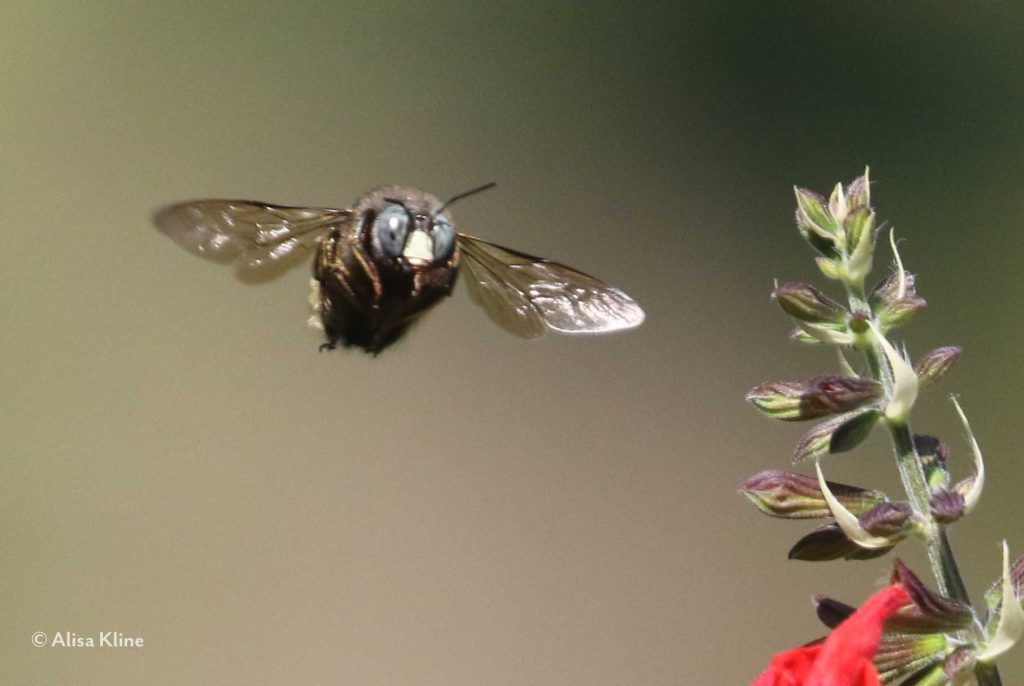
I am thrilled to see the Park so well used during our coronavirus lockdown. Sanity can be found on those paths. The blog, however, requires quiet, empty spaces that are not as easily found in the Park nowadays. However, I do still have access to a secret (not really) nature preserve a half-mile north of the Park. In other words, my yard.
I’m not sure how long I can keep this going with just my yard as material. I guess it depends on how long we are locked down. When I start to post about chickens, you’ll know I’m just about out of good ideas.
So, that out of the way, meet my favorite bee! That’s him at the top of this post. This fellow is, brace yourself, Xylocopa tabaniformis parkinsoniae. The common names aren’t much of an improvement. You can choose from horsefly-like carpenter bee or Parkinson’s carpenter bee. I have chosen the latter. He is always one of the first native bees to get to work in my yard each spring and he’s everywhere right now, testing out those shiny new wings.
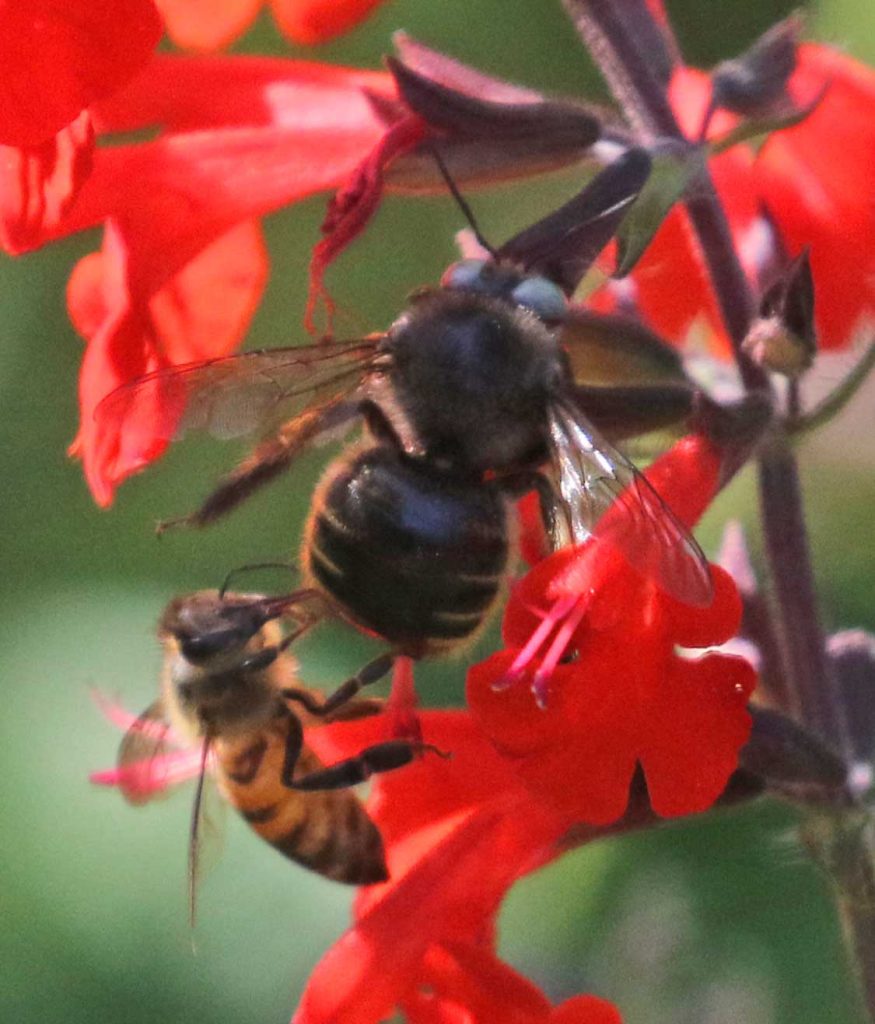
This is a good size comparison. The Parkinson’s CB is above and a honey bee is below. The carpenter bee is almost double her size, and Parkinsons is not a big carpenter bee.
They are new because he is. Of our native bees, only two, the southern carpenter bee and a queen bumblebee, live through the winter. Our other native bees live for only a single season. Each generation spends its first and only winter as a (usually) solitary larvae, snug in a compartment his or her mother built for them the summer before. She provisioned each tiny cell with a loaf of pollen held together with nectar.
When it is spring and pollen and nectar are easy to find, the larvae pupate and emerge as adult bees. The females of many species, including our Parkinson’s carpenter bee, lay their eggs in a sequence that ensures that male offspring will emerge before the females.
The males emerge first for two reasons. First, because it makes their one and only job (find a female) a little easier. Being born first, they hang around the entrances of other nests knowing that pretty soon, a female will emerge. He can mate with her, and job done! Having now lived his life to the fullest, he gets to hang around sipping nectar until his tiny clock runs out, which won’t be long now.
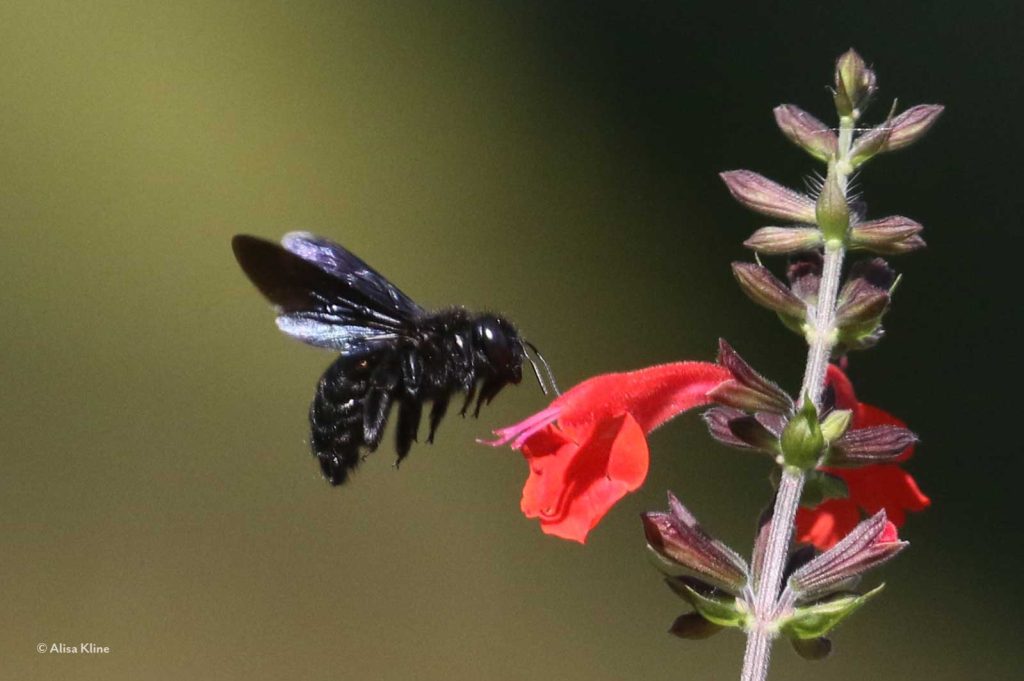
This is another carpenter bee in my yard right now. I think he is a Mexican carpenter bee. The reason I’m including him in this post is because of the tiny feet dangling down in the photo. Such cuteness must be shared.
The other reason males are born first is that one male can fertilize the eggs of many females, but only the female can lay the eggs within her. Females, individually are more valuable. With tube nests, if a predator gets in, they will eat the first in line first, and second in line second. If all the males are packed at the entry of the tube, they will get eaten first, second, third, etc. But if even one male survives, all the females packed in the back will be able to reproduce.
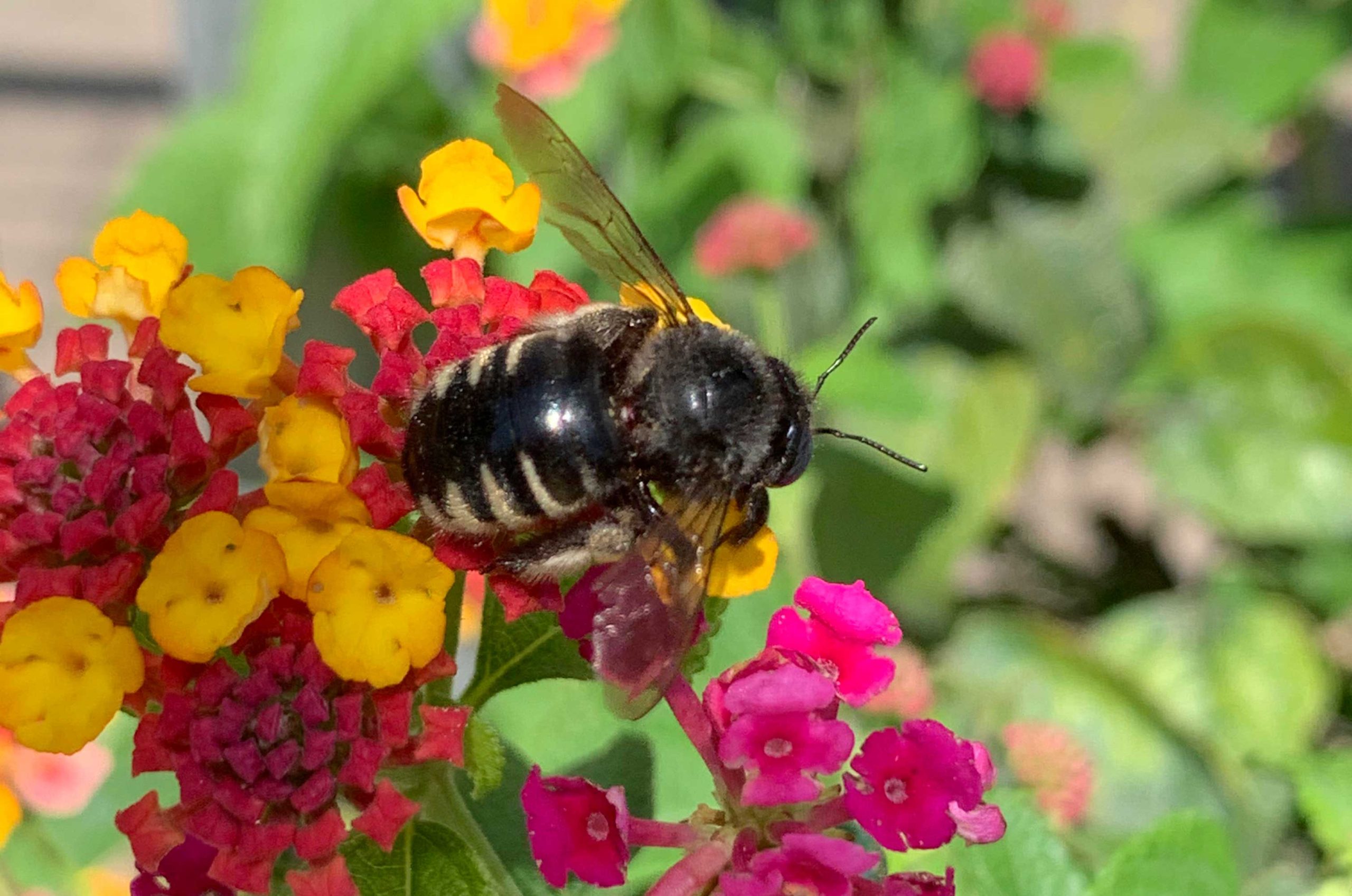
The back of the Parkinson’s CB are also distinctive. They have stripes that don’t reach all the way across her back, giving them a signature look
The females, on the other hand, are going to be phenomenally busy. First, they mate and then the work starts. For a carpenter bee, job one is to bore a hole in wood, preferably soft-wood that’s perhaps a little rotted. Once the main tunnel is drilled, she begins constructing tiny apartments. She mixes the sawdust residue of the wood she has chewed through with saliva to make particle board that she uses to divide the tunnel into tiny apartments. Each one will house a single egg and a pollen loaf.
All day, she collects pollen and makes the tiny loaves and then she lays an egg in each cell and seals it with a loaf inside. Every day is the same until, by the end of the season, she has filled her nest with eggs and she, too, is done.
I think the thing I love most about Parkinsons’ carpenter bees is that, with the huge blue/green eyes and yellow face patch, their faces look like faces, not something frequently encountered in insects. Without thinking much about it, I have always looked forward to seeing them in spring and have come to understand that they won’t be around all summer. They are a spring thing.
Later in the year, I fill with bees that look extremely like the spring bees, but disappointingly lack the face patch and so are lovely, but slightly less so.
Clever readers know where this is going. Male carpenter bees almost all have a patch of color on their faces. Females never do. My early adorable bees are the boys and later, they are replaced, almost entirely, by the girls.
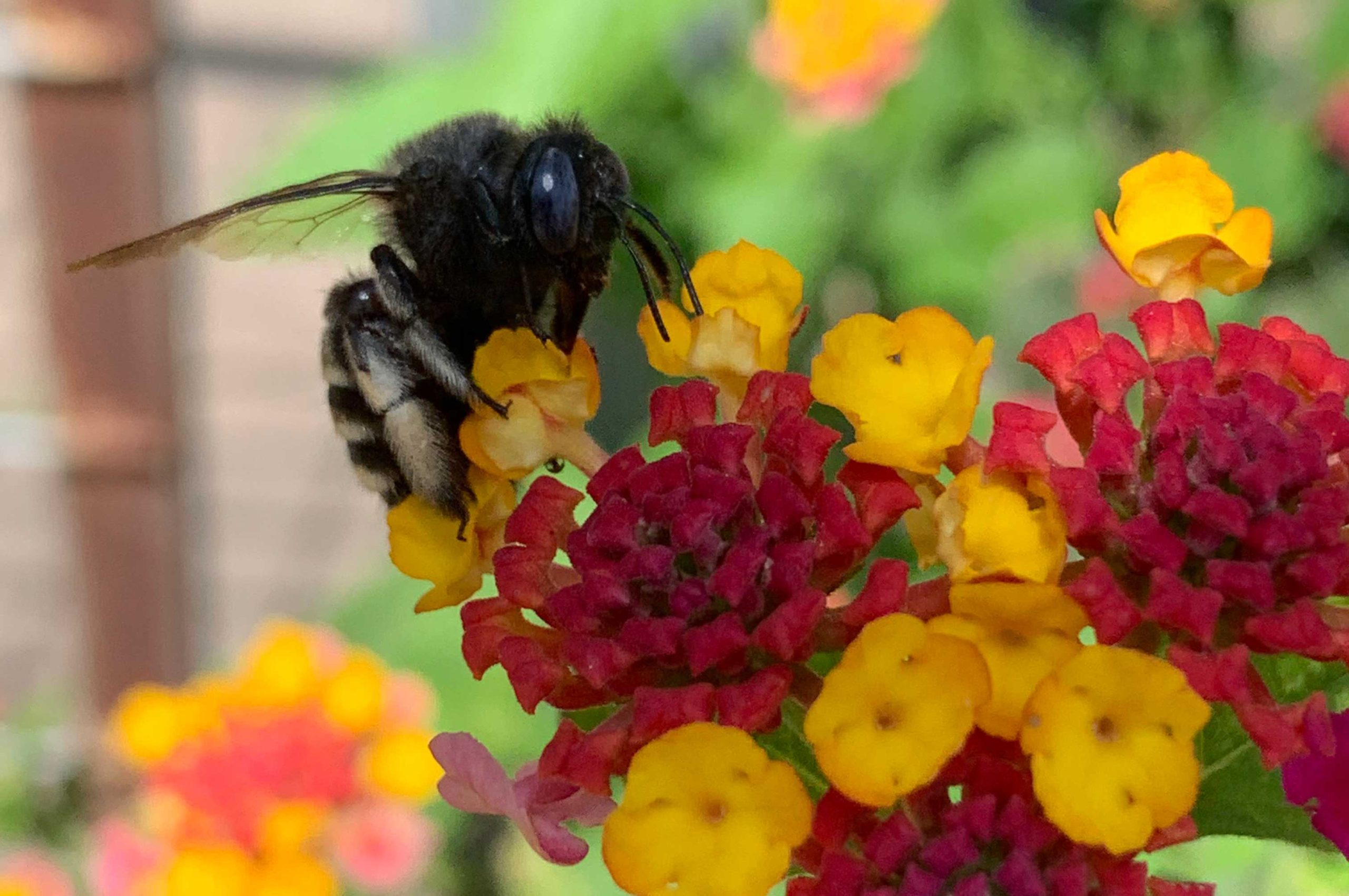
This is a female Parkinson’s CB. You can see that she lacks the face patch and her eyes aren’t as striking. But you can see the huge elongated eyes that prompted the horsefly reference in her common name.
The irritating thing is that I knew both facts, about the face patch and about the life cycle, but it wasn’t until writing this post that I put it together.
So, the boys are back in town and living it up. Long may they reign.
I would love to add information about the life cycle etc., but the only two people I have found who have ever devoted time to this bee are myself and Tina Huckabee a fellow naturalist in Austin who writes lovingly of them in her blog.
I checked with iNaturalist and found that reports of the bee cluster in two regions, central Texas down through Mexico and Central America and on the west coast. There is an interesting smattering in from Utah down to New Mexico that seems to track national forests and parkland.
Here in Houston, iNaturalist shows a total of only 27 sightings inside the loop. The only one ever reported in the Park was by me. I am amazed by this because these are really stunning bees and I would imagine that anyone seeing one would try to identify
it.
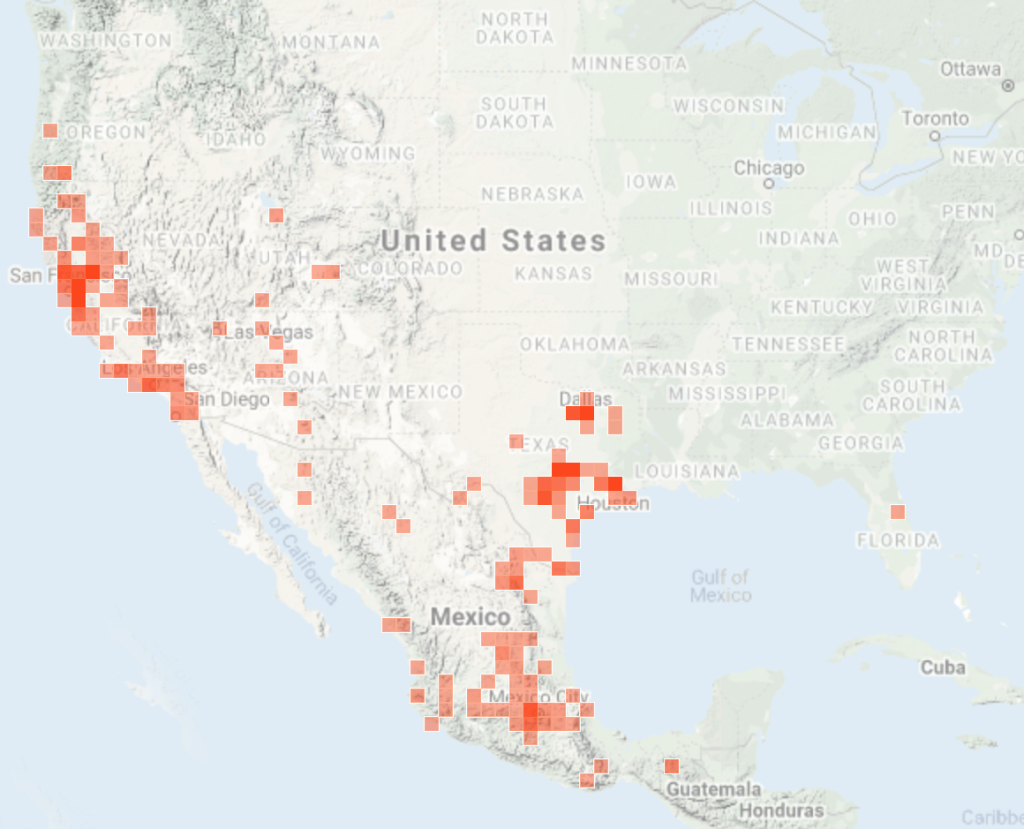
Distribution map of iNaturalist postings of Parkinson’s carpenter bee.
If you wish to draw these beauties to your yard, consider the brush pile. Pick a back corner of your yard and decide not to worry about that corner. Then, toss branches and limbs and general yard debris into that corner. Pretty soon, you’ve got habitat going. And don’t worry about that corner. It’s not for you. It’s for them. They like things a bit messy. They will make their nests in the limbs you have tossed aside and they will visit your flowers and make your life completely better!
Beaver alert
I ran into Rick Potter on a Park trail in January. Rick and the Park beavers have some sort of affinity and I’m hugely envious. He sent me the first video in January and the second this week.
Houston Naturama
We have a winner! Judith Schott found four of the five challenge plants and I am eternally grateful to her because the rest of you left me hanging. In Judith’s honor, and in hope of more nature lovers, there will be five new challenges posted to this site on Saturday. Her name has been enshrined on the Houston Naturama honor roll as soon as I create it. Think Saturday!
There will be a new challenge posted on the blog on Saturday. And I expect a better response! Come on, people. Houston needs you!

